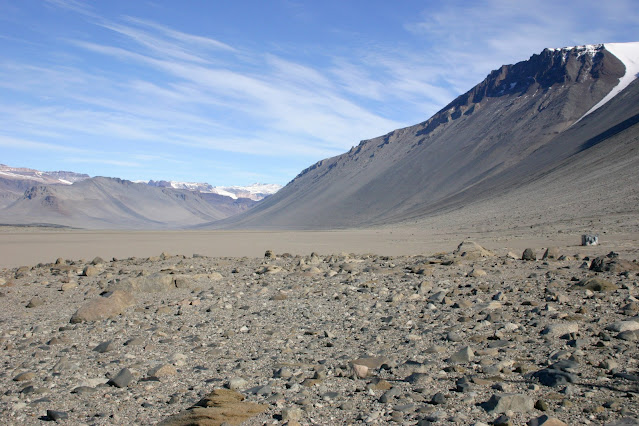What an exciting morning! We sailed into what was the Bay of Whales so named by Shackleton when he sailed here on the Nimrod leading the 1907 British Antarctic Expedition. Some years later Amundsen sailed here and established a temporary base right on the Ross Ice Shelf itself - a risky decision but it got him just that little bit closer to the South Pole than Scott. The Bay of Whales created by the Ross Ice Shelf disappeared in 1987 when a chunk 154km long (B-9) broke off from the Shelf. Like glaciers ice shelves calve so they are potentially very dangerous - Amundsen was lucky.
 |
Watching at the bow rail as we sail into the Ross Sea
|
 |
| You might need to zoom in to see the group of orcas ahead of the ship |
 |
| Penguins are one of the favourites of Orcas so they were all out of the water on drifting ice |
As we were sailing south to that southernmost point, a large pod of Orcas was spotted ahead of us, so we all rushed to the best vantage points to see them. They are stunning creatures. Meanwhile, as we were trying to get closer to the Orcas, the captain was taking us further and further south until, barring a few metres (we were a matter of seconds away), we reached the most southerly point possible for a ship to reach - 78.44 degrees latitude, a little over 1000km to the geographic South Pole.
 |
| The edge of the massive Ross Ice Shelf |
We were almost up against the ice shelf (which incidentally is about the size of France). Quite a noteworthy occasion so the captain gathered us and the crew on the helipad to get a photo and drink a toast with chilled champagne. It was pretty cold -4.6C so mulled wine would probably have been better but it’s a French ship so champers it was! We stood around in the icy air for almost an hour ‘enjoying’ the moment then dashed back inside to the bar for hot chocolate.
Eventually we sailed out of the Bay to head west along the edge of the ice shelf to Cape Crozier (the eastern end of Ross Island) where there’s a huge Adelie Penguin colony. Unfortunately we were not able to land as it's a protected breeding area for Adeline Penguins. Towering behind the Cape is Mount Terror, an extinct volcano on Ross Island.
 |
| The gruesome effects of frost bite for one of the Crozier explorers |
A team of 3 brave men, the Crozier group, from the Terra Nova expedition trekked to Cape Crozier in 1911. In addition to mapping and exploring they were interested in collecting penguin eggs in order to investigate any evolutionary links to reptiles. They found a few eggs and one of the party put them inside his fur mitten. As a result he got frost bit on his fingers which swelled with fluid and froze - sheer agony. One of that small team, Aspley Cherry-Garrard, described it as ‘The Worst Journey in the World’ and indeed from his description, it must have been brutal.
Polar exploration is a harsh unforgiving venture. I include this small advertisement which was not for that particular expedition but which attracted thousands of applicants. And it seems that each expedition seemed to attract more applicants than could be taken on board - in fact there were a few stowaways. A boy's own adventure!
As we were navigating further west along the Ross Ice Shelf towards the Ross Sea, we were treated to another cooking session; today it was Butter Brioche with the ship’s baker, Alexandre Gabriel.





































































